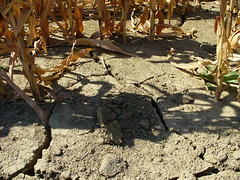 There are many ecosystems on earth not rich in vegetation and other organisms. This is natural wherever there is low rainfall and hostile ground. However, there are other areas, in theory able to sustain a variety of living organisms, with enough rainfall and mild climate, but which have as little variety as the first category. Their soil remains poor and unsuitable for vegetation. Such ecosystems have been eroded by human activities, often to the point of desertification.
There are many ecosystems on earth not rich in vegetation and other organisms. This is natural wherever there is low rainfall and hostile ground. However, there are other areas, in theory able to sustain a variety of living organisms, with enough rainfall and mild climate, but which have as little variety as the first category. Their soil remains poor and unsuitable for vegetation. Such ecosystems have been eroded by human activities, often to the point of desertification.
Desertification never describes the presence of a natural desert. It is the process of making an area look like a desert, having its characteristics while it should not. It is caused by acid rain, deforestation and the setting of fires. Also, because of overgrazing when plants start to grow again after a fire. Most of the times there is a combination of some or of all those factors, which are all connected with human activities.
During desertification, many animal species die or lose their natural habitat. Plants disappear and face extinction. Valuable sources are lost, as fewer plants produce less oxygen. Thus, it is connected with global warming and climate change. Moreover, desertification often results in floods, as there are no trees to keep the soil steady with their roots. Floods harm both natural ecosystems and human properties, sometimes including death tolls.
Consequently, desertification is a very serious problem and should be solved. Laws ought to be passed in order to decrease the amount of trees cut down and of wooden products one can buy. Carbon dioxide emissions, by which acid rain is caused, must be reduced to prevent soil erosion. Authorities have to protect forests, by organising fire brigades and immediate reforestations. Animals that graze should be kept away from burnt areas where plants have just started to grow again.
Recommended Comments
There are no comments to display.
Join the conversation
You can post now and register later. If you have an account, sign in now to post with your account.